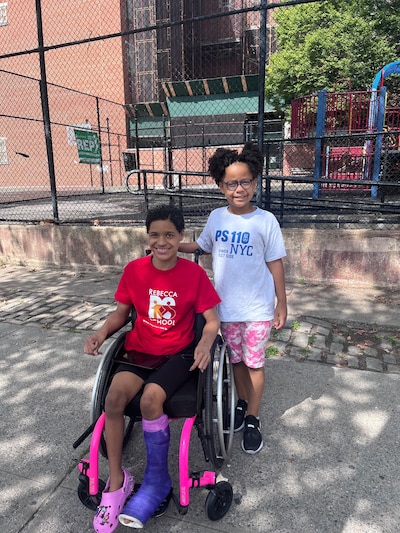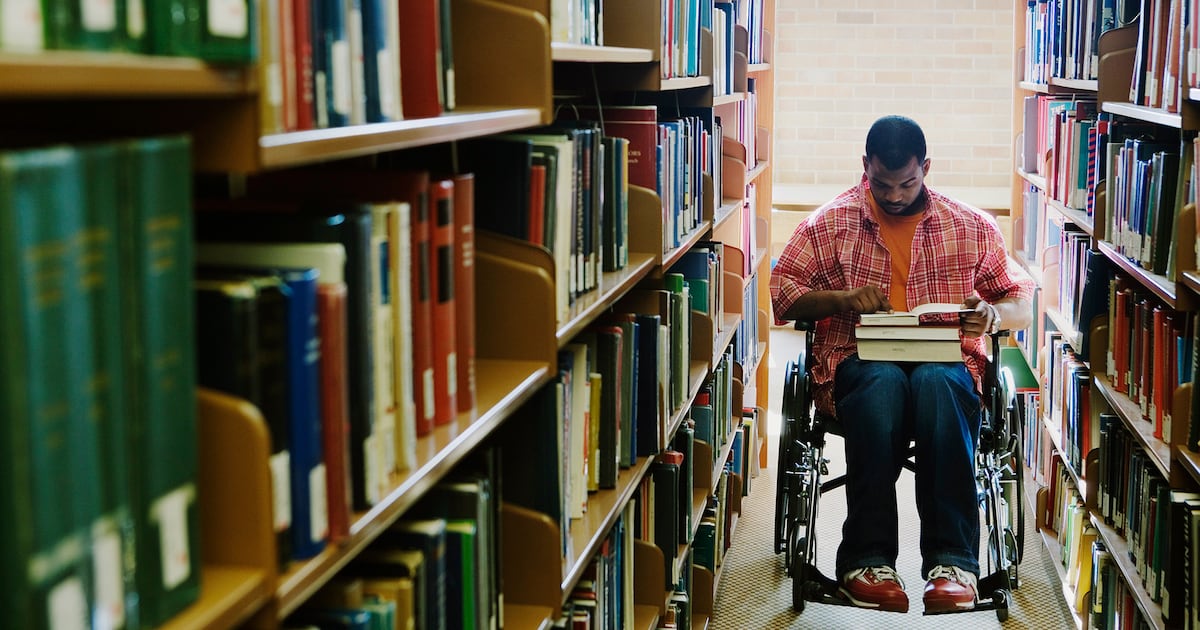To stay up to date on the latest news about New York City public schools, sign up for Chalkbeat New York’s free daily newsletter.
Fewer than one in three New York City public schools accommodate students with physical disabilities, according to a report released Wednesday by child advocacy groups, who are calling on the city to provide more funding for school building renovations.
The city is set to release its first five-year capital plan for schools in November, and the group is pushing to raise $1.25 billion to more quickly address major gaps in building accessibility.
The funding, which would run from 2025 to 2029, would allow about half of the city’s schools to remain fully open and address long-standing issues that have been criticized by parents and federal prosecutors, according to the report. The City Council is expected to approve the funding plan in June, but it is typically revised twice a year after that.
City officials have made some progress in recent years, thanks in large part to pressure from advocates who successfully lobbied the city to allocate $750 million to the effort in its current 2020-2024 capital plan.
The city would increase the percentage of fully accessible programs under its current capital program from about 1 in 5 schools to 1 in 3, according to an analysis by child advocates. (That figure doesn’t include certain alternative schools, preschool programs or charter schools, nor does it include satellite campuses, because schools may have multiple locations.)
“This is a big step forward and really shows that if we’re committed to making our schools barrier-free, we can make a big difference,” said Sarah Peart, a policy analyst at Advocates for Children. “The current lack of accessibility is not inevitable.”
Inaccessible school buildings have long been a barrier for students with disabilities, leaving them with few or no options for neighborhood schools. They also limit their ability to take advantage of New York City’s broader choice system, which allows children to enroll in schools outside their home neighborhoods. About 39% of schools don’t have classrooms that accommodate students who need mobility assistance, according to a report by child advocates.
Abraham Weitzman, a junior at Columbia University, has cerebral palsy and uses a wheelchair, and through the eighth grade he commuted to a private school by bus, more than an hour each way.
“I lived across from an elementary school that was difficult to get to,” Weitzman said in an email, “and there was no opportunity to find community in my neighborhood.”
Weitzman eventually enrolled in Bard High School Early College Queens, a fully accessible public school, but had difficulty navigating the high school admissions process, and she quickly discovered that although many campus staff and students were welcoming, the buildings were not as welcoming.
Once, he was visiting a school he liked, but his wheelchair wouldn’t fit in the bathroom, so his mother had to carry him to a private room.
Despite his positive experience at Bard, Weitzman wrote that it is “shameful” that students with disabilities have no access throughout the public school system. “We must work to make a better environment for our future students.”
Despite improvements in building accessibility, barriers remain for students
Federal officials are also taking notice of serious accessibility issues.
In 2015, then-US Attorney Preet Bharara released an investigation that found New York City’s elementary schools had accessibility problems so severe they violated the Americans with Disabilities Act of 1990. Many of the city’s school buildings were over 100 years old, but Bharara found that the city had failed to improve accessibility when renovating older buildings.
Peart said the city has made serious efforts to improve accessibility in recent years, but the scale of the problem and the amount of funding needed to fully address it means that even if the city follows child advocates’ requests for more funding, roughly half of schools will still not be fully accessible by 2029, nearly 40 years after the Americans with Disabilities Act was passed.
Asked about their accessibility goals, city officials noted improvements have been made over the past five years but declined to say whether they wanted to make all schools fully accessible.
“This report recognizes how much progress we’ve made and the ongoing $750 million in our current capital plan that we have committed toward our shared goal of making school buildings more accessible,” School Construction Authority spokesman Kevin Ortiz said in a statement, referring to the Advocates Children’s analysis.
City officials have made incremental progress, including making improvements to some buildings “partially accessible.” About 20% of the city’s school buildings meet this definition, meaning some classrooms and facilities, but not all, can accommodate students with disabilities.
In recent years, the city has begun publishing more detailed school-level reports outlining areas that are accessible to students with disabilities, and Advocates for Children has also produced a map to accompany the report with school-level accessibility information.
Even partially accessible buildings can pose significant obstacles: Manhattan mother Yuvania Espino sent her daughter Mia Simpson, who has cerebral palsy and uses a wheelchair, to a partially accessible elementary school in East Harlem that specializes in students with disabilities.
But the main entrance was at the top of a small flight of stairs, forcing the family to stand by a separate entrance each day, sometimes in the rain, while waiting for staff to unlock the door.
Mia attended classes on the first floor of the school and was denied access to certain classrooms and supports on other floors, including a gym on the second floor that serves students with sensory disabilities. Over time, many of Mia’s friends were moved to classrooms on other floors, which caused distress for Mia and led to behavioral problems, Espino said.
 Mia Simpson (left) poses for a photo with her sister, Kira. When Mia was attending New York City public school, she was not allowed into certain classrooms or to use the school’s front entrance. (Courtesy of Yuvania Espino)
Mia Simpson (left) poses for a photo with her sister, Kira. When Mia was attending New York City public school, she was not allowed into certain classrooms or to use the school’s front entrance. (Courtesy of Yuvania Espino)
“To this day, I don’t know what impact having an elevator would have had on Mia’s academic performance in school,” Espinso said. The family ultimately decided to send Mia to a more accessible private school, where the city would cover her tuition.
Mia, now 14, still struggles with transportation issues – she often has to miss performances and other events at her sister’s public school because the auditorium is on the second floor and has no elevator.
“Parents shouldn’t have to think about access to a school building when they enroll their child in school,” Espino said. “I’m thrilled that we’ve taken small steps, but we need to tighten our belts and take bigger steps.”
Alex Zimmerman is a reporter for Chalkbeat New York covering New York City public schools. Contact Alex at [email protected].

